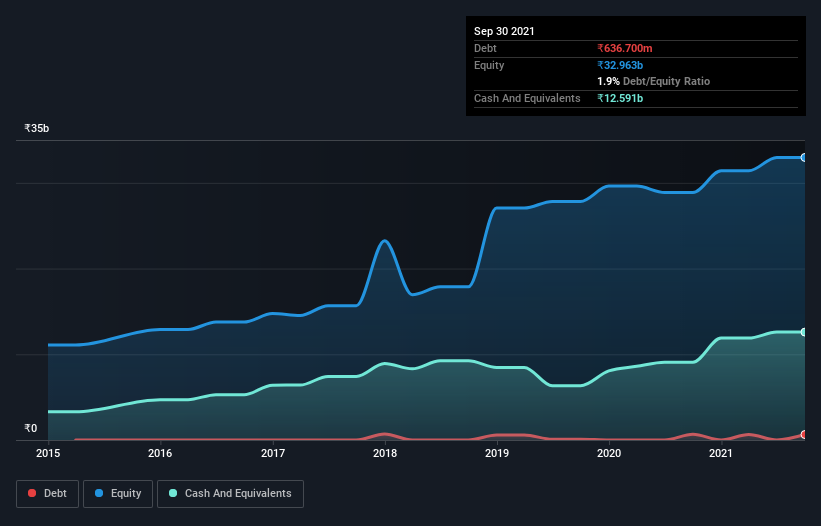These 4 Measures Indicate That Schaeffler India (NSE:SCHAEFFLER) Is Using Debt Safely

Legendary fund manager Li Lu (who Charlie Munger backed) once said, 'The biggest investment risk is not the volatility of prices, but whether you will suffer a permanent loss of capital.' When we think about how risky a company is, we always like to look at its use of debt, since debt overload can lead to ruin. We can see that Schaeffler India Limited (NSE:SCHAEFFLER) does use debt in its business. But the more important question is: how much risk is that debt creating?
When Is Debt A Problem?
Debt assists a business until the business has trouble paying it off, either with new capital or with free cash flow. If things get really bad, the lenders can take control of the business. While that is not too common, we often do see indebted companies permanently diluting shareholders because lenders force them to raise capital at a distressed price. By replacing dilution, though, debt can be an extremely good tool for businesses that need capital to invest in growth at high rates of return. When we examine debt levels, we first consider both cash and debt levels, together.
Check out our latest analysis for Schaeffler India
What Is Schaeffler India's Debt?
As you can see below, Schaeffler India had ₹636.7m of debt, at June 2021, which is about the same as the year before. You can click the chart for greater detail. However, it does have ₹12.6b in cash offsetting this, leading to net cash of ₹12.0b.

How Strong Is Schaeffler India's Balance Sheet?
According to the last reported balance sheet, Schaeffler India had liabilities of ₹11.2b due within 12 months, and liabilities of ₹598.1m due beyond 12 months. Offsetting these obligations, it had cash of ₹12.6b as well as receivables valued at ₹7.76b due within 12 months. So it can boast ₹8.56b more liquid assets than total liabilities.
This short term liquidity is a sign that Schaeffler India could probably pay off its debt with ease, as its balance sheet is far from stretched. Simply put, the fact that Schaeffler India has more cash than debt is arguably a good indication that it can manage its debt safely.
Better yet, Schaeffler India grew its EBIT by 141% last year, which is an impressive improvement. That boost will make it even easier to pay down debt going forward. When analysing debt levels, the balance sheet is the obvious place to start. But it is Schaeffler India's earnings that will influence how the balance sheet holds up in the future. So if you're keen to discover more about its earnings, it might be worth checking out this graph of its long term earnings trend.
But our final consideration is also important, because a company cannot pay debt with paper profits; it needs cold hard cash. Schaeffler India may have net cash on the balance sheet, but it is still interesting to look at how well the business converts its earnings before interest and tax (EBIT) to free cash flow, because that will influence both its need for, and its capacity to manage debt. During the last three years, Schaeffler India produced sturdy free cash flow equating to 66% of its EBIT, about what we'd expect. This free cash flow puts the company in a good position to pay down debt, when appropriate.
Summing up
While we empathize with investors who find debt concerning, you should keep in mind that Schaeffler India has net cash of ₹12.0b, as well as more liquid assets than liabilities. And we liked the look of last year's 141% year-on-year EBIT growth. So we don't think Schaeffler India's use of debt is risky. Above most other metrics, we think its important to track how fast earnings per share is growing, if at all. If you've also come to that realization, you're in luck, because today you can view this interactive graph of Schaeffler India's earnings per share history for free.
If, after all that, you're more interested in a fast growing company with a rock-solid balance sheet, then check out our list of net cash growth stocks without delay.
If you're looking to trade Schaeffler India, open an account with the lowest-cost platform trusted by professionals, Interactive Brokers.
With clients in over 200 countries and territories, and access to 160 markets, IBKR lets you trade stocks, options, futures, forex, bonds and funds from a single integrated account.
Enjoy no hidden fees, no account minimums, and FX conversion rates as low as 0.03%, far better than what most brokers offer.
Sponsored ContentNew: Manage All Your Stock Portfolios in One Place
We've created the ultimate portfolio companion for stock investors, and it's free.
• Connect an unlimited number of Portfolios and see your total in one currency
• Be alerted to new Warning Signs or Risks via email or mobile
• Track the Fair Value of your stocks
This article by Simply Wall St is general in nature. We provide commentary based on historical data and analyst forecasts only using an unbiased methodology and our articles are not intended to be financial advice. It does not constitute a recommendation to buy or sell any stock, and does not take account of your objectives, or your financial situation. We aim to bring you long-term focused analysis driven by fundamental data. Note that our analysis may not factor in the latest price-sensitive company announcements or qualitative material. Simply Wall St has no position in any stocks mentioned.
Have feedback on this article? Concerned about the content? Get in touch with us directly. Alternatively, email editorial-team (at) simplywallst.com.
About NSEI:SCHAEFFLER
Schaeffler India
Engages in the development, manufacture, and distribution of high-precision roller and ball bearings, and related components worldwide.
Excellent balance sheet average dividend payer.
Similar Companies
Market Insights
Community Narratives



